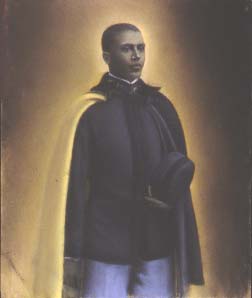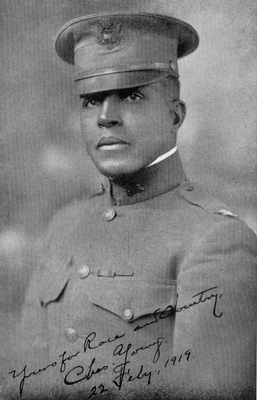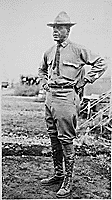
| Colonel Charles Young is remembered and honored as a man of unique courage and inspiration. This was especially true for those of "goodwill", who knew him, and for those who followed him into battle. He stands honored both as an African-American and in the history of African-Americans in the U.S. military. Young was born March 12, 1864 to exslaves in the little hamlet of MaysLick, Kentucky. He graduated from the U.S. Military Academy at West Point in 1889. This gave him the honor of being the third African-American to do so, in spite of the hatred, bigotry and discrimination he encountered as an undergraduate. His first assignment after graduation was with the Buffalo Soldiers in the 10th Cavalry in Nebraska, and then in the 9th and 10th Cavalries in Utah. With the outbreak of the Spanish-American War, he was reassigned as Second Lieutenant to training duty at Camp Algers, Virginia. Young was then awarded a commission as a Major in the Ninth Ohio Volunteer Infantry. Later, during the Spanish-American War, he was in command of a squadron of the 10th Cavalry Buffalo Soldiers in Cuba. After the war with Spain, Young was reassigned to Fort Duchesne in Utah where he successfully arbitrated a dispute between Native Americans and sheep herders. He also met one of the many soldiers who would eventually benefit from his encouragement, Sergeant Major Benjamin O. Davis. Later, Davis would became General Benjamin O. Davis, the first African-American to reach the rank of General in the U.S. army. Charles Young distinguished himself throughout his military career with the Buffalo Soldiers of the 9th and 10th Cavalries, and the 25th Infantry. He also served as Professor of Military Science at Wilberforce University, Ohio. With the creation of the army's Military Information Division (MID), came his assignment as one of the army's first military attachés, in Port Au Prince, Haiti. His job was to observe the training and exercises of foreign armies and make reports on their relative strengths and weaknesses. United States intelligence was desperate for new maps and information about groups struggling for political power in Haiti. Young risked his life to fulfill his assignments, only to have his maps and reports stolen and sold to the Haitian government. In 1903 Captain Young was in command of the 10th Cavalry, who were segregated at the Presidio of San Francisco. He was assigned "Acting Superintendent" of Sequoia National Parks in California for the summer. The management of the park was the responsibility of the army, which had very little Congressional funding. This problem and the fact that no "Acting Superintendent" of Sequoia National Parks ever stayed at this assignment for more than two consecutive summers resulted in the construction of less than five miles of roads within the park. The lack of a wagon road severely limited the number for people who visited the Giant Forest of Redwoods, which are the largest trees in the world.
Young was sent to the Philippines to join his 9th regiment and command a squadron of two troops in 1908. Four years later he was once again selected for Military Attaché duty, this time to Liberia. For his service as adviser to the Liberian Government and his supervision of the building of the country's infrastructure, he was awarded the Springarn Medal, an award that annually recognized the African-American who had made the highest achievement during the year in any field of honorable human endeavor. During the 1916 Pershing's Punitive Expedition into Mexico, Young was praised for his leadership in the pursuit of the bandit Pancho Villa, who had murdered American citizens. Commanding a squadron of the 10th United States Cavalry, he led a cavalry pistol charge against the Villista forces, routing the opposing forces without losing a single man. The swift action saved the wounded General Beltran and his men, who had been outflanked. On another occasion, Young was credited with averting disaster when he and his men came to the relief of the 13th U.S. Cavalry squadron who were fighting a heavy rear guard action. Because of his exceptional leadership of the 10th Cavalry in the Mexican theater of war, he was promoted to Lieutenant Colonel and was briefly Fort Huachuca's commander in Texas. Young was devoted to his wife Ada and their two children; son, Charles Jr. and daughter Marie. He was sure to have played the piano, and at least a few of his compositions, when he was home between assignments. Being versatile, he also played the violin and guitar. Linguistically, he spoke several languages. Colonel Charles Young was the highest ranking African-American officer in the army when WW1 started. He was also the first African-American to reach that rank in the army. With the explosive arrival of WW1, the public, and especially African-Americans considered the possibility of Young receiving a major leadership role in the war. He had met challenges of racism, bigotry, and discrimination embedded within society and within the military. He had shown himself to be exceptional, not only as an military officer, but also as a leader of men. But justice and the rule of equality in the military were not for Lt. Colonel Charles Young. When he took his scheduled army physical, the doctors said his blood pressure was too high. Young and his comrades, his supporters, and the African-American news media believed otherwise. On June 22, 1917, Young was retired, under protest.
 Too
weak to command in France they said, but not too weak to traverse
and suffer the swamps of West Africa, Colonel Charles Young,
was once again, assigned to Liberia as Military Attaché.
He died at that post on January 8, 1922, while on a research
expedition in Lagos, Nigeria. SENATE RESOLUTION 97
African-American Experience in Ohio, Colonel Charles Young Collection, 1897 - 1931. #1 African-American Experience in Ohio, Colonel Charles Young Collection, 1897 - 1931. #2 African-American Experience in Ohio, Colonel Charles Young Collection, 1897 - 1931. #3 Huachuca Illustrated, The Buffalo Soldiers at Fort Huachuca: Colonel Charles Young, Black Cavalryman, Huachuca Commander and Early Intelligence Officer
Send
e-mail to: sldavis@buffalosoldier.net |
